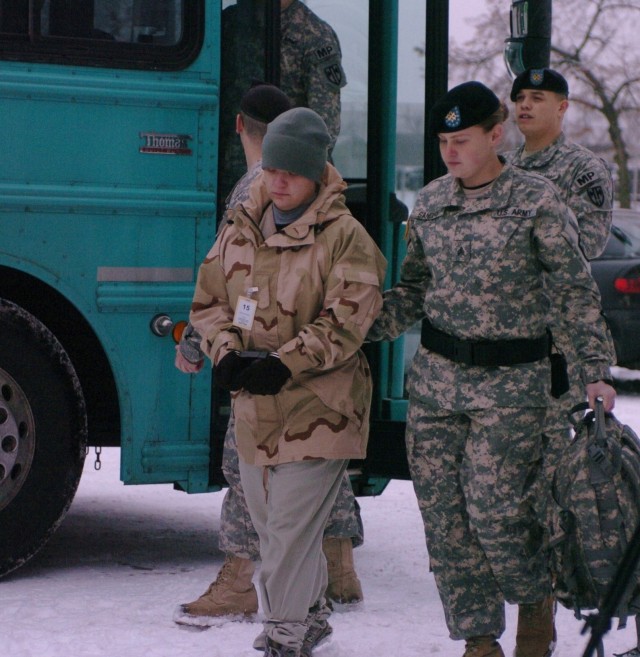KAISERSLAUTERN, Germany - For a short while, they were all able to get out of jail free, but fortunately they were not "real" prisoners.
The 9th Military Police Detachment practiced its emergency evacuation procedures with 34 Soldiers playing the role of prisoners at the U.S. Army Confinement Facility, Europe on Coleman Barracks in Mannheim, Germany, Jan. 13.
The 9th MP Det., 95th Military Police Battalion is a subordinate unit of the 21st Theater Sustainment Command's 18th Military Police Brigade. It operates USACF-E, which is the only authorized permanent place of confinement for military prisoners in the European theater and an accredited level 1 facility.
Therefore, the 9th MP Det. must meet numerous standards relating to health, safety, security and operational procedures set forth by the American Correctional Association as well as comply with military rules and regulations, said Maj. Chad Goyette, the facility commander.
For this quarter's training exercise, more than 170 personnel were involved, to include key personnel at U.S. Army Garrison Mannheim.
"In reality, (USAG) would be executing the evacuation plan and determine a place to move the jail population to as well. Furthermore, we would work through them for things like food and transportation," Goyette said. "The more realistic the exercise, the more impact it has."
The exercise scenario proposed the confinement facility unfit to occupy due to a fire, thus necessitating the evacuation of the entire jail population. Approximating reality, USAG Mannheim provided a gymnasium as a facility to house and feed the prisoners
"At the outset of this exercise, we can already judge it a success because of the excellent cooperation between the different units and agencies and USAG in particular," Goyette said.
For added impact, the role players, wearing prison attire representing their supposed level of confinement, had scripts. The scripts detailed the severity of the injuries sustained in the fire and the degree to which their behavior should run to compliancy or trouble making, etc. Of course, stressors could and would be added as necessary, Goyette explained.
"Since the guard force is not privy to the scripts, we'll be able to observe their initiative and also evaluate their leadership skills," Goyette said.
For the five observers, who were on hand to systematically analyze and evaluate every step of the exercise, it was not always easy to limit themselves to observation.
"Having worked in this field for a number of years, we know what right looks like. Sometimes it's hard to not interfere and just let things go," said Goyette.
The facility's sergeant major agreed and pointed out the crucial role training plays.
"You cannot have failure in a confinement facility. The better prepared you are, the better equipped you are to deal with emergencies and incidents," Sgt. Maj. Michael Borlin said.
"Anytime anything happens at a confinement facility, it has a strategic impact," said Maj. Samuel Harvill, the former USACF-E commander and current commander for the 95th MP Bn.'s rear detachment.
At the end of the day, observers deemed the strategic planning for the exercise successful.
"It was very successful and met the commander's intent in every point and facet," Borlin said.




Social Sharing